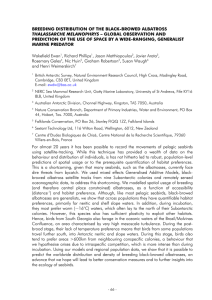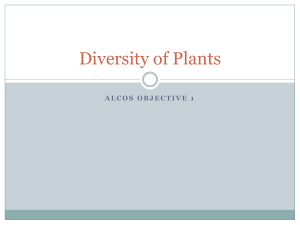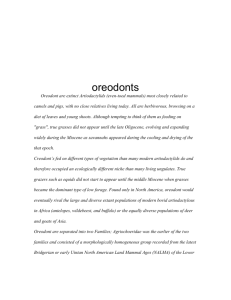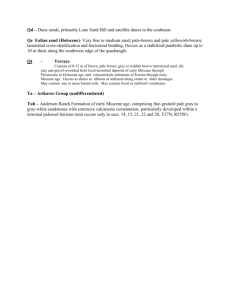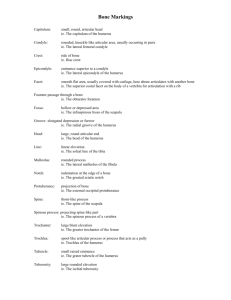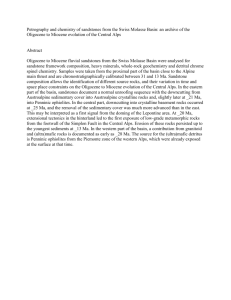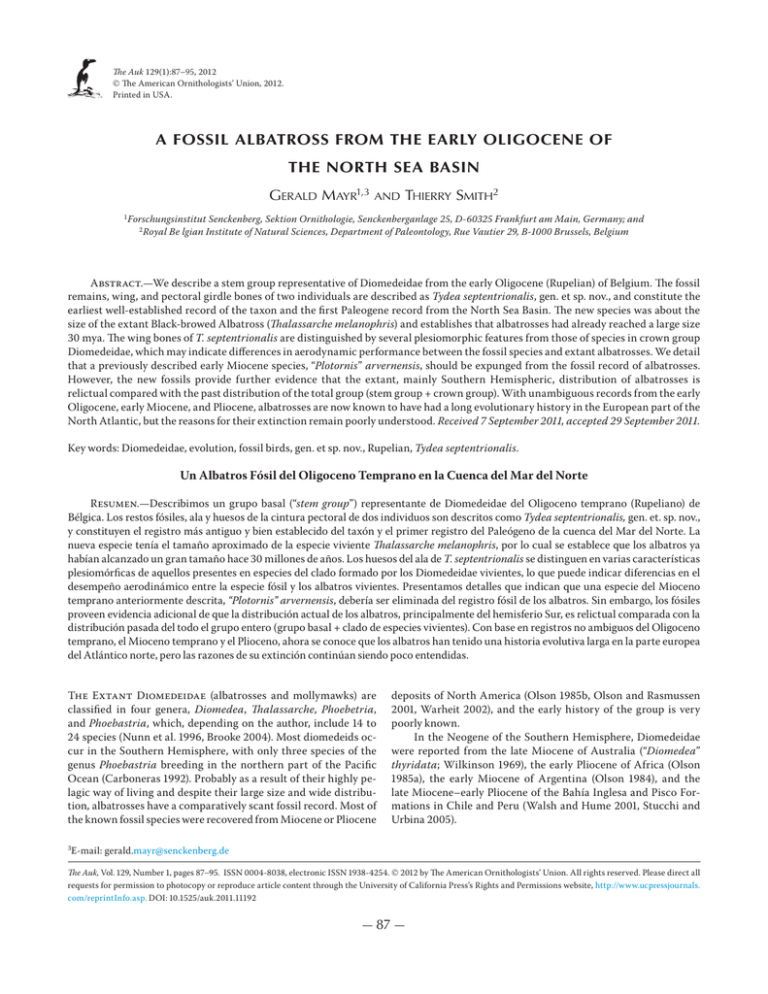
The Auk 129(1):87−95, 2012
© The American Ornithologists’ Union, 2012.
Printed in USA.
A FOSSIL ALBATROSS FROM THE EARLY OLIGOCENE OF
THE NORTH SEA BASIN
GERALD MAYR1,3
1
AND
THIERRY SMITH2
Forschungsinstitut Senckenberg, Sektion Ornithologie, Senckenberganlage 25, D-60325 Frankfurt am Main, Germany; and
2
Royal Be lgian Institute of Natural Sciences, Department of Paleontology, Rue Vautier 29, B-1000 Brussels, Belgium
Abstract.—We describe a stem group representative of Diomedeidae from the early Oligocene (Rupelian) of Belgium. The fossil
remains, wing, and pectoral girdle bones of two individuals are described as Tydea septentrionalis, gen. et sp. nov., and constitute the
earliest well-established record of the taxon and the first Paleogene record from the North Sea Basin. The new species was about the
size of the extant Black-browed Albatross (Thalassarche melanophris) and establishes that albatrosses had already reached a large size
mya. The wing bones of T. septentrionalis are distinguished by several plesiomorphic features from those of species in crown group
Diomedeidae, which may indicate differences in aerodynamic performance between the fossil species and extant albatrosses. We detail
that a previously described early Miocene species, “Plotornis” arvernensis, should be expunged from the fossil record of albatrosses.
However, the new fossils provide further evidence that the extant, mainly Southern Hemispheric, distribution of albatrosses is
relictual compared with the past distribution of the total group (stem group + crown group). With unambiguous records from the early
Oligocene, early Miocene, and Pliocene, albatrosses are now known to have had a long evolutionary history in the European part of the
North Atlantic, but the reasons for their extinction remain poorly understood. Received September , accepted September .
Key words: Diomedeidae, evolution, fossil birds, gen. et sp. nov., Rupelian, Tydea septentrionalis.
Un Albatros Fósil del Oligoceno Temprano en la Cuenca del Mar del Norte
Resumen.—Describimos un grupo basal (“stem group”) representante de Diomedeidae del Oligoceno temprano (Rupeliano) de
Bélgica. Los restos fósiles, ala y huesos de la cintura pectoral de dos individuos son descritos como Tydea septentrionalis, gen. et. sp. nov.,
y constituyen el registro más antiguo y bien establecido del taxón y el primer registro del Paleógeno de la cuenca del Mar del Norte. La
nueva especie tenía el tamaño aproximado de la especie viviente Thalassarche melanophris, por lo cual se establece que los albatros ya
habían alcanzado un gran tamaño hace millones de años. Los huesos del ala de T. septentrionalis se distinguen en varias características
plesiomórficas de aquellos presentes en especies del clado formado por los Diomedeidae vivientes, lo que puede indicar diferencias en el
desempeño aerodinámico entre la especie fósil y los albatros vivientes. Presentamos detalles que indican que una especie del Mioceno
temprano anteriormente descrita, “Plotornis” arvernensis, debería ser eliminada del registro fósil de los albatros. Sin embargo, los fósiles
proveen evidencia adicional de que la distribución actual de los albatros, principalmente del hemisferio Sur, es relictual comparada con la
distribución pasada del todo el grupo entero (grupo basal + clado de especies vivientes). Con base en registros no ambiguos del Oligoceno
temprano, el Mioceno temprano y el Plioceno, ahora se conoce que los albatros han tenido una historia evolutiva larga en la parte europea
del Atlántico norte, pero las razones de su extinción continúan siendo poco entendidas.
The Extant Diomedeidae (albatrosses and mollymawks) are
classified in four genera, Diomedea, Thalassarche, Phoebetria,
and Phoebastria, which, depending on the author, include to
species (Nunn et al. , Brooke ). Most diomedeids occur in the Southern Hemisphere, with only three species of the
genus Phoebastria breeding in the northern part of the Pacific
Ocean (Carboneras ). Probably as a result of their highly pelagic way of living and despite their large size and wide distribution, albatrosses have a comparatively scant fossil record. Most of
the known fossil species were recovered from Miocene or Pliocene
3
deposits of North America (Olson b, Olson and Rasmussen
, Warheit ), and the early history of the group is very
poorly known.
In the Neogene of the Southern Hemisphere, Diomedeidae
were reported from the late Miocene of Australia (“Diomedea”
thyridata; Wilkinson ), the early Pliocene of Africa (Olson
a), the early Miocene of Argentina (Olson ), and the
late Miocene–early Pliocene of the Bahía Inglesa and Pisco Formations in Chile and Peru (Walsh and Hume , Stucchi and
Urbina ).
E-mail: gerald.mayr@senckenberg.de
The Auk, Vol. , Number , pages −. ISSN -, electronic ISSN -. © by The American Ornithologists’ Union. All rights reserved. Please direct all
requests for permission to photocopy or reproduce article content through the University of California Press’s Rights and Permissions website, http://www.ucpressjournals.
com/reprintInfo.asp. DOI: ./auk..
— 87 —
88
— M AYR
AND
“Diomedea” californica Miller, and “D.” milleri Howard, were described from the middle Miocene of the North
American Pacific coast (Olson b, Warheit ). The former
of these two species was likened to Phoebastria anglica (see below)
by Olson and Rasmussen (), who also referred Diomedea howardae Chandler, from the late Pliocene of California as well
as albatross remains from the Miocene of Florida to the extant
Phoebastria albatrus. Another North Pacific albatross, Diomedea
tanakai Davis, from the early Miocene of Japan, was considered to be the earliest fossil representative of the genus Diomedea
(Davis ).
Diomedeidae were also reported from the Atlantic coast of
North America, where albatrosses today occur only as vagrants.
A still undescribed distal humerus from the middle Miocene Calvert Formation of Maryland was mentioned by Olson (b), and
abundant material of two extinct and three extant diomedeid species, all in the genus Phoebastria, was found in the early Pliocene
Yorktown Formation of the Lee Creek Mine in North Carolina
(Olson and Rasmussen ). The latest record of Diomedeidae
in the North Atlantic dates from the Pleistocene of the Bermudas,
where Phoebastria albatrus had a breeding colony until ,
years ago (Olson and Hearty ).
Several fossil albatrosses have also been reported from the Cenozoic of Europe, but identification of some of these has not been
convincingly established. One of the uncontroversial records is
Plotornis delfortrii Milne-Edwards, from the early Miocene of
the Atlantic coast in southwestern France (Fig. C, E), which is represented by a tarsometatarsus and distal humeri (Milne-Edwards
). Cheneval’s () classification of another species, “Plotornis” arvernensis from the early Miocene of central France, into Diomedeidae, however, seems to be unjustified, and the material needs
to be restudied in order to determine its affinities. The holotype
tarsometatarsus of this species (Fig. A, B, D) was originally assigned to Procellariidae, as “Puffinus arvernensis” (Shufeldt ),
and referred to Plotornis by Cheneval (). With a length of only
. mm (Cheneval ), the bone is from a bird about half the
size of the smallest extant albatross (Fig. A, B, D). Its distal end is
proportionally narrower than in P. delfortrii and other Diomedeidae and, unlike in albatrosses, the articular surface of the trochlea
for the fourth toe is not sloping laterally (Fig. ). In addition to the
tarsometatarsus, Cheneval () tentatively referred a coracoid to
P. arvernensis, which likewise shows little resemblance to the corresponding bone of albatrosses and was considered to be from a pathological individual. Apart from its morphological dissimilarity, it
is highly unlikely that “P”. arvernensis represents an albatross, because the fossils were found in lacustrine sediments that were deposited > km away from any seashore.
The fragmentary holotype material of “Diomedea” rumana
Grigorescu and Kessler, from the middle Miocene (MN ,
about mya) of Romania, the proximal and distal ends of an ulna
(Grigorescu and Kessler ), distinctly differs from Diomedeidae and other Procellariiformes in the much larger olecranon
and the shape of the tuberculum carpale, and is also unlikely to be
from an albatross or even procellariiform bird.
Apart from P. delfortrii, the only unambiguous European
diomedeid species is thus Phoebastria anglica from the late Pliocene of England, which is represented by a tarsometatarsus and
several referred bones (Olson and Rasmussen , Dyke et al.
SMITH —
AUK, VOL. 129
FIG. 1. Left tarsometatarsi of two fossils from the early Miocene of France
that were referred to Diomedeidae. (A, B, D) “Plotornis” arvernensis (holotype; from Cheneval 1984) in (A, B) dorsal and (D) plantar view. (C, E)
Plotornis delfortrii (cast of holotype in the collection of Université Claude
Bernard, Lyon) in (C) dorsal and (E) plantar view. Note the different orientation of the distal end of trochlea metatarsi IV as indicated by the dotted
lines in A and C. In B and C the actual size of the bones are compared.
Scale bars = 10 mm.
). Soldaat et al. () further mentioned undescribed diomedeid remains from the late Neogene (presumably Pliocene) of
the Netherlands.
Even on a global scale, the Paleogene fossil record of albatrosses is very scanty (Mayr b). Murunkus subitus Panteleyev
and Nessov, , an alleged diomedeid species from the middle
Eocene of Uzbekistan (Panteleyev and Nessov ), is known
from a single carpometacarpus. Although this specimen closely
resembles the carpometacarpus of albatrosses, it is from a very
small species, about one-third the size of the smallest extant species, and its affinities need to be established with further material (the assumption that it belongs to the extinct procellariiform
Diomedeoididae [Mayr b:] can, however, not be upheld; De
Pietri et al. ). Tambussi and Tonni () reported an incomplete tarsometatarsus from the late Eocene of the La Meseta Formation of Seymour Island in Antarctica. The specimen has not
been figured, but the authors noted features in which it is distinguished from extant Diomedeidae and resembles Plotornis. These
differences evidently refer to “Plotornis” arvernensis, and because
that species is unlikely to be an albatross (see above), a restudy of
the Seymour Island fossil is desirable. Manu antiquus from the
late Oligocene (Duntroonian) of New Zealand (Marples )
is based on an incomplete furcula and has been compared with
Diomedeidae in the original description. The morphology of the
bone is, however, very different from that of extant diomedeids
and does not support identification of the species as an albatross
(Olson b, Mayr b). As suggested by Mayr (b) and
Mayr and Rubilar-Rogers (), the species may instead belong
to the extinct taxon Pelagornithidae (bony-toothed birds). Finally,
J ANUARY 2012
— E ARLY O LIGOCENE A LBATROSS —
Olson (b) mentioned an undescribed, Plotornis-like humerus
fragment from the late Oligocene Chandler Bridge Formation in
South Carolina.
Here, we describe unambiguous Paleogene records of Diomedeidae from the early Oligocene (Rupelian) of Belgium. The fossils
were found in the Boom Formation, whose sediments were deposited in a shallow open sea in the southwestern part of the North
Sea Basin (Vandenberghe et al. ). Despite the fact that these
specimens constitute the most substantial Paleogene fossil record
of Diomedeidae found so far, they remained unstudied since their
discovery > years ago.
M ATERIAL
AND
M ETHODS
Osteological terminology follows Baumel and Witmer (). For
convenience, the term “albatrosses” is used for all crown group
Diomedeidae. Institutional abbreviation: IRSNB, Institut royal
des Sciences naturelles de Belgique, Belgium.
Comparisons were made with skeletons of the following extant
species of Diomedeidae (all in the collection of Forschungsinstitut
Senckenberg): Thalassarche cauta, Th. chlororhynchos, Th. melanophris, Diomedea antipodensis, D. epomophora, D. exulans, and
Phoebetria fusca. For the humerus, ulna, and carpometacarpus of
Phoebastria species, the figures in Olson and Rasmussen ()
were consulted.
SYSTEMATIC PALEONTOLOGY
Procellariiformes Fürbringer, 1888
Diomedeidae Gray, 1840
Tydea, gen. nov.
Type species.—Tydea septentrionalis, sp. nov.
Differential diagnosis.—Differs from Plotornis and crown
group Diomedeidae in the smaller and more proximally directed
processus supracondylaris dorsalis of the humerus (compare Fig.
K, O); further differs from crown group Diomedeidae in that
crista bicipitalis without marked cranial bulge (compare Fig. A,
F), impressio ligamenti acrocoracohumeralis of coracoid more
marked (Fig. H, J), and facies articularis humeralis of scapula
proportionally larger and tuberculum coracoideum more prominent (Fig. L, M).
Etymology.—From Tydeus, in Greek mythology the father of
Diomedes, from which the genus name Diomedea is derived.
Tydea septentrionalis, sp. nov.
Holotype.—IRSNB Av a-m (Figs. and ; proximal and
distal ends of right humerus, fragmentary distal left humerus
in two pieces, fragmentary distal end of right ulna, fragmentary
distal end of right carpometacarpus, distalmost tip of left carpometacarpus, incomplete right phalanx proximalis digiti majoris,
extremitas cranialis and distal section of blade of left scapula,
fragmentary right coracoid, tip of processus acrocoracoideus of
left coracoid, fragment of left scapus claviculae); all bones are
from the same individual; they were found on December
by Georges Hasse.
Type locality and horizon.—Terhagen near Antwerp; Boom
Formation, early Oligocene (Rupelian).
89
Diagnosis.—As for genus; Tydea septentrionalis, sp. nov. was
about the size of the extant Thalassarche melanophris.
Measurements (in millimeters).—Humerus, maximum width
of proximal end (IRSNB Av a), .; maximum width of distal end (IRSNB Av b) as preserved, .. Coracoid (IRSNB Av
k), maximum length as preserved, .. Scapula (IRSNB Av
i), width of extremitas cranialis, .. Phalanx proximalis digiti
majoris (IRSNB Av h), maximum length, .. Carpometacarpus (IRSNB Av g), maximum craniocaudal width of distal end,
.; estimated total length (IRSNB Av g + IRSNB Av ), ~.
Referred specimen.—IRSNB Av (Fig. S, T; proximal left
carpometacarpus); collection Bernays-de Gottal; from Rumst
near Antwerp, early Oligocene (Rupelian).
Etymology.—From septem (Lat.), seven, and triones (Lat.),
plow oxen, in reference to the seven stars of the constellation Ursa
Major (Great Bear); the term “septentrionalis” refers to northern
latitudes.
Comments.—The holotype of Tydea septentrionalis consists
of wing and pectoral girdle bones only. However, the material
catalogued under IRSNB Av also includes four pedal phalanges, presumably from the fourth toe. Although these match the
wing bones in size, they exhibit a morphology very different from
the much more elongated and narrower pedal phalanges of albatrosses. Given the great similarity in the morphology of the wing
bones, we consider it unlikely that early Oligocene Diomedeidae
had a completely different toe morphology than their extant relatives and other procellariiform birds. Because other avian specimens from the Boom Formation in the collection of IRSNB also
constitute a mix of different species, we assume that the pedal
phalanges are not from T. septentrionalis.
Description and comparisons.—In addition to an incomplete
right coracoid, which lacks most of the omal and sternal extremities (Fig. B–D), the material also includes the tip of the processus
acrocoracoideus of the left coracoid (Fig. F–H). This latter specimen is similar to the processus acrocoracoideus of Thalassarche
spp. in its shape but exhibits a more marked impressio ligamenti
acrocoracohumeralis than all extant species of Diomedeidae (Fig.
H), and the facies articularis clavicularis does not form a lip overhanging the sulcus supracoracoideus (this lip is particularly pronounced in Diomedea spp.). On the right coracoid, the foramen
nervi supracoracoidei is still filled with sediment but has the same
size and position as in modern albatrosses. The overall proportions of the bone closely match those of extant diomedeids. As
in modern albatrosses and in contrast to other procellariiform
birds, the medial portion of the extremitas sternalis is dorsoventrally wide, and the facies interna of the crista articularis sternalis appears to have been very prominent. Whether the impressio
musculi sternocoracoidei on the dorsal surface of the extremitas
sternalis bears pneumatic foramina as in crown group diomedeids
(Fig. A) cannot be discerned owing to the fragmentary and poor
preservation of the specimen.
The scapula differs from that of crown group Diomedeidae in
that the facies articularis humeralis is proportionally larger, more
craniocaudally elongated, and less cranially directed (Fig. L, M).
The tuberculum coracoideum is somewhat more prominent than
in extant albatrosses. The extremitas cranialis as a whole is less
ventrally expanded than in the species of crown group Diomedeidae, in which it has a subtriangular shape with a straight cranial
90
— M AYR
AND
SMITH —
AUK, VOL. 129
FIG. 2. Humerus and ulna of Tydea septentrionalis, gen. et sp. nov., from the early Oligocene of Belgium in comparison with extant Macronectes
giganteus (Procellariidae; E) and Thalassarche melanophris (Diomedeidae; F–H, K, M). (A–D) Proximal end of right humerus (holotype, IRSNB
Av 94a) in (A) cranial, (B) caudal, (C) proximal, and (D) ventral view. (E) Proximal end of right humerus of M. giganteus in caudal view. (F, G)
Proximal end of right humerus of Th. melanophris in (F) cranial, (G) caudal, and (H) ventral view. (I, J, L) Distal end of right humerus (holotype,
IRSNB Av 94b) in (I) caudal, (J) cranial, and (L) dorsal view. (K) Distal end of right humerus of Th. melanophris in cranial view. (M) Distal end of
left humerus of Th. melanophris in dorsal view. (N) Distal end of left humerus (holotype, IRSNB Av 94c) in cranial view. (O, P) Distodorsal portion of left humerus (holotype, IRSNB Av 94d) in (O) cranial and (P) dorsal view. (Q, R) Distal end of right ulna (IRSNB Av 94e) in (Q) ventral
and (R) dorsal view. The arrows in K and O indicate the direction of the processus supracondylaris dorsalis. All fossil specimens coated with
ammonium chloride. Abbreviations: bul = cranial bulge of crista bicipitalis, cbp = crista bicipitalis, cdd = condylus dorsalis, cdf = crus dorsale
fossae, cdp = crista deltopectoralis, cdv = condylus ventralis, cph = caput humeri, fmb = fossa musculi brachialis, fpt = fossa pneumotricipitalis, pit = pits on epicondylus dorsalis, psd = processus supracondylaris dorsalis, tbd = tuberculum dorsale, tbv = tuberculum ventrale, and
tsv = tuberculum supracondylare ventrale.
J ANUARY 2012
— E ARLY O LIGOCENE A LBATROSS —
91
FIG. 3. Wing and pectoral girdle bones of Tydea septentrionalis, gen. et sp. nov., from the early Oligocene of Belgium in comparison to extant Thalassarche melanophris (Diomedeidae). (A, E) Right coracoid of Th. melanophris in (A) dorsal and (E) medial view. (B–D) Fragmentary right coracoid (holotype, IRSNB Av 94k) in (B) dorsal, (C) ventral, and (D) medial view. (F–H) Processus acrocoracoideus of left coracoid (holotype, IRSNB Av 94l) in (F)
dorsal, (G) omal, and (H) ventral view. (I, J) Processus acrocoracoideus of left coracoid of Th. melanophris in (I) dorsal and (J) ventral view. (K, M, N) Left
scapula (holotype, IRSNB Av 94i+j) in (K) medial and (M, N) lateral view. (L) Left scapula of Th. melanophris in lateral view. (O, P) Fragment of omal section of left scapus claviculae (holotype, IRSNB Av 94m) in (O) cranial and (P) caudal view. (Q, R) Distal tip of left carpometacarpus (holotype, IRSNB Av
94g) in (Q) ventral and (R) distal view. (S, T) Proximal left carpometacarpus (IRSNB Av 95) in (S) ventral and (T) dorsal view. (U) Left carpometacarpus of
Th. melanophris in ventral view. (V, W) Distal section of right carpometacarpus (holotype, IRSNB Av 94f) in (V) ventral and (W) dorsal view. (X, Y) Right
phalanx proximalis digiti majoris (holotype, IRSNB Av 94h) in (X) dorsal and (Y) ventral view. All fossil specimens coated with ammonium chloride. Abbreviations: acr = acromion, fah = facies articularis humeralis, fin = facies interna of crista articularis sternalis, fns = foramen nervi supracoracoidei, fur =
tendinal furrows of musculi interosseus dorsalis et ventralis, ila = impressio ligamenti acrocoracohumeralis, pex = processus extensorius, pii = processus
internus indicis, pnf = pneumatic foramina, ppf = processus pisiformis, sul = medial sulcus on scapus claviculae, and tbc = tuberculum coracoideum.
92
— M AYR
AND
margin in Thalassarche and Phoebetria and a much more prominent acromion in Diomedea.
Only a small portion of the left scapus claviculae of the furcula is preserved, which stems from the proximal section, just
sternal of the extremitas omalis (Fig. O, P). The bone fragment
agrees well with the corresponding section of the furcula of extant
diomedeids. Its sternal half has a convex cranial and flat caudal
surface, and the omal portion bears a shallow notch on its craniolateral surface. Unlike in modern diomedeids, however, there is a
sulcus on the medial surface of the omal portion, at the base of the
extremitas omalis (Fig. O).
Because of the action of pyrite decay, the proximal end of
the humerus is badly preserved, and there is still very hard matrix attached to parts of the bone. The characteristic derived features of the albatross humerus are, nevertheless, clearly visible,
and apart from the characters noted below, the preserved morphology closely resembles the proximal humerus of extant diomedeids. The proximal margin of the bone is straight, and the
caput humeri is small and only weakly proximally protruding.
The tuberculum ventrale is strongly developed and the incisura
capitis very wide as in modern albatrosses. The sulcus transversus appears to have been very short and shallow as in the extant
species, but its exact extent is not visible because of overlying
matrix. As in the recent species of Diomedeidae and unlike in
other procellariiform birds, the crus dorsale fossae is reduced
and the fossa pneumotricipitalis shallow (Fig. B). A pneumatic
foramen within the latter fossa is not visible, but the corresponding area is too poorly preserved for close examination. In crown
group diomedeids, the crista bicipitalis forms a very marked cranial bulge and has a bloated appearance (Fig. F). Although the
corresponding area of the humerus is damaged in the fossil, a
large cranial protrusion almost certainly was absent. The crista
bicipitalis itself is less proximodistally stretched than in the species of crown group Diomedeidae and, contrary to the latter, it
is cranially raised in its proximal section. In ventral view, the
proximal portion of the crista bicipitalis, just distal of the tuberculum ventrale, is thus craniocaudally wider than in crown
group diomedeids (Fig. D). The crista deltopectoralis is broken;
the caudal surface of the humerus adjacent to it is slightly concave, whereas it is flat in crown group diomedeids. In its distal
section, the dorsal margin of the shaft is craniocaudally slanted
as in extant albatrosses; the narrow ventral margin forms a
ridge. The fossa musculi brachialis is very wide and shallow as
in the species of extant Diomedeidae. The condylus dorsalis is
too damaged for meaningful comparisons. The condylus ventralis matches that of modern diomedeids, and as in the latter,
the ventral portion of this condyle slants craniocaudally. The
tuberculum supracondylare ventrale is elongated as in modern
albatrosses and has a slightly convex cranial surface (on the right
humerus the proximal portion of this tubercle is missing). The
processus supracondylaris dorsalis of the right humerus is broken, but the process is preserved on the isolated distodorsal portion of the left humerus (Fig. O, P). Although the humerus shaft
is not preserved in this fragment, the processus supracondylaris
dorsalis is complete and much smaller and more proximally directed than in other Diomedeidae, including Plotornis, in which
it is a large dorsal projection perpendicular to the long axis of the
humerus (Fig. K). The two ligamental pits on the dorsal surface
SMITH —
AUK, VOL. 129
of the epicondylus dorsalis are further situated more closely together than in crown group diomedeids, in which they are well
separated (Fig. L, M).
The poorly preserved ulna (Fig. Q, R) does not allow for extensive comparisons, but the morphologies of the condylus dorsalis, depressio radialis, and incisura tendinosa do not differ from the
species of extant Diomedeidae (e.g., Thalassarche melanophris).
Likewise, the carpometacarpus closely resembles that of
extant diomedeids (Fig. ) and, apart from being about × larger, is
also similar to that of the middle Eocene Murunkus subitus. As in
extant albatrosses and M. subitus, the tip of the processus extensorius is wide and broadly rounded, whereas it is more pointed in
other Procellariiformes. The processus pisiformis forms a trough
for the tendon of musculus flexor digitorum profundus. On the
dorsal surface of the proximal end of the bone, the fossa supratrochlearis is marked as in Phoebetria fusca and Diomedea spp.,
whereas it is shallow in Thalassarche spp. The sulcus tendinosus slopes caudally toward the distal end of the bone; the fossa
at its distal end is proportionally somewhat shorter than in modern albatrosses (in the fossil it begins at the end of the spatium
intermetacarpale, whereas it starts well before in crown group
diomedeids). As in the species of crown group Diomedeidae, there
are two short but well-marked sulci for the tendons of musculi interosseus dorsalis et ventralis on the dorsal surface of the symphysis metacarpi distalis (Fig. W). Also as in extant albatrosses and
M. subitus, the facies articularis digitalis minor does not reach as
far distally as facies articularis digitalis major.
The preserved portion of the phalanx proximalis digiti majoris (Fig. X, Y) does not differ from that of extant diomedeids; as in
the latter, there is a small processus internus indicis.
D ISCUSSION
Assignment of Tydea septentrionalis, gen. et sp. nov., to Diomedeidae is straightforward and, apart from the large size of the
remains, supported by the characteristic derived morphology
of the humerus, which, unlike in other Procellariiformes, exhibits () a strongly reduced crus dorsale fossae, () a shallow
fossa pneumotricipitalis, and () a very long and narrow tuberculum supracondylare ventrale. Further derived morphologies
shared by T. septentrionalis and crown group diomedeids are
() the wide and broadly rounded processus extensorius of the
carpometacarpus and () the extremitas sternalis of the coracoid, whose medial section is very wide dorsoventrally (Fig. D,
E). The species is distinguished from Pelagornithidae, the only
avian taxon with which a confusion would be possible, by several
features, such as the thicker bone walls, the smaller processus
acrocoracoideus of the coracoid, the morphology of the proximal humerus, whose caput, for example, does not form a cranial overhang, the less concave lateral surface of the extremitas
cranialis of the scapula, and the less proximodistally elongated
processus extensorius and symphysis metacarpalis distalis of
the carpometacarpus (e.g., Bourdon et al. , Mayr and Smith
, Mayr and Zvonok ).
The furcula of Tydea septentrionalis is very unlike that of Manu
antiquus from the late Oligocene of New Zealand, in which the omal
section of the scapus claviculae is much wider, thus providing further
evidence against diomedeid affinities of this latter species (see above).
J ANUARY 2012
— E ARLY O LIGOCENE A LBATROSS —
Although T. septentrionalis closely resembles the species of
extant Diomedeidae in its overall morphology, it is shown to be
outside crown group Diomedeidae by several plesiomorphic features, such as () the shorter processus supracondylaris dorsalis
(as detailed by Mayr a, a short process is plesiomorphic for
Procellariiformes), () the absence of a marked cranial bulge on
the crista bicipitalis (this feature is an autapomorphy of crown
group diomedeids and does not occur in other Procellariiformes
and most other birds), () the marked impressio ligamenti acrocoracohumeralis of the coracoid (the impression is marked in
Procellariidae and most other birds), and () the larger facies articularis humeralis of the scapula (the condition in Tydea resembles
that in non-diomedeid Procellariiformes).
The Rupelian deposits of the Boom Formation in Terhagen
have an age of – Ma (Abels et al. ), and Tydea septentrionalis is thus ≥ Ma older than the early Miocene Plotornis delfortrii, which comes from the Neogene stratigraphic unit MN -
(Cheneval ) and has an age of ~ million years. Nunn et al.
() estimated that the earliest divergences within the two major clades of crown group Diomedeidae occurred about mya
(Diomedea–Phoebastria) and mya (Phoebetria–Thalassarche),
and our study provides a calibration point outside the crown
group for future divergence estimates based on molecular data.
Tydea septentrionalis is the first Paleogene record of Diomedeidae from the North Sea Basin and documents a long evolutionary history of albatrosses on the Northern Hemisphere. Previous
Paleogene records of putative Diomedeidae (i.e., the early Eocene
Murunkus subitus and the unnamed late Eocene record from Antarctica) represent species significantly smaller than extant albatrosses. As shown by T. septentrionalis, however, albatrosses had
already reached a large size in the early Oligocene.
The close similarity of the wing bones, especially the shape of
the proximal humerus, whose small caput restricted rotatory movements, indicates that T. septentrionalis was already well adapted to
soaring over long distances. Notably, however, the processus supracondylaris dorsalis on the distal humerus is distinctly shorter and
more proximally directed in T. septentrionalis than in Plotornis and
extant Diomedeidae (Fig. K, O). This process serves as attachment
site for the tendon of musculus extensor carpi radialis and ligaments
connected with the ligamentum propatagiale, and its enlargement
in procellariiform birds is often correlated with the presence of a
large, strut-like sesamoid bone, which stabilizes the propatagium
(Brooks , Mayr a). The distinct differences in the development of this process in T. septentrionalis and crown group Diomedeidae are likely to correspond with differences in flight technique or
aerodynamic characteristics of the wing, and the fossil species may
not yet have been adapted to dynamic soaring to the same degree as
crown group Diomedeidae (e.g., Pennycuick ). A detailed analysis of the functional morphology of the supracondylar process in
extant Procellariiformes is, however, needed before conclusions can
be drawn on its significance in the fossil.
Early Oligocene terrestrial avifaunas of Europe include many
groups that do not occur on this continent today, such as hummingbirds and todies (Mayr b), and our study adds a marine
taxon to this list. Albatrosses obtain their food, mainly squid and
fish, from the sea surface, and most extant species occur in areas
with productive marine upwellings, such as the Benguela Current
along southwest Africa and the Humboldt Current at the South
93
American west coast. Distribution of these highly pelagic birds
in the high latitudes of the Southern Hemisphere is also favored
by the persistence of strong winds, whereas most of the much
calmer equatorial regions do not offer suitable habitats for albatrosses (Carboneras ). Early Oligocene global oceanic and atmospheric circulation systems were, however, very different from
those of today. Although a proto-Humboldt current may have already existed in the late Eocene (Marty et al. ), strong coastal
upwelling commenced in the early Miocene (Ibaraki ), and
onset of high productivity of the Benguela Current was not before
the late Miocene (Diester-Haass et al. ). Global atmospheric
circulation was also subjected to changes through time, and today’s wind distribution is, among other factors, a result of the
marked pole-to-equator temperature gradients, which emerged
during the Cenozoic (Rea and Janecek ).
Occurrence of albatrosses in the Oligocene of the North Sea
basin probably reflects such historical geophysical differences, but
albatrosses persisted in the North Atlantic until the late Pliocene
(England) or even Pleistocene (Bermuda), and the reasons that led
to their extinction are poorly understood. Olson and Hearty ()
hypothesized that a mid-Pleistocene interglacial sea-level rise led to
the extirpation of a Phoebastria albatrus breeding colony on Bermuda, but these authors also noted that other North Atlantic albatross species seem to have vanished before. North Atlantic seabird
communities in general were much more diversified in the Pliocene
than they are today (Olson and Rasmussen , Olson and Hearty
, Smith ), and disappearance of albatrosses from the North
Atlantic was only one chapter in the profound turnovers in seabird
communities during the Pliocene, a period that, for example, witnessed the global extinction of the large pelagornithids, which were
also large marine soaring birds (Mayr and Rubilar-Rogers ).
Both tectonic processes (e.g., changes in oceanic circulation systems due to closure of the Panamanian Isthmus and disappearance
of breeding grounds because of sea-level rises) and ecological interactions (e.g., competition for breeding space with gregarious pinnipeds) have been considered important factors in the evolution of
seabird communities (Warheit , ), but a full understanding is still hampered by our incomplete knowledge of the exact temporal and geographic distribution of many taxa in question (Olson
and Hearty ). It is notable that there are few, if any, records of
large marine Laridae and Stercorariidae before the Pliocene (Olson
b, De Pietri et al. ). Whether there is any causal relation
between the late diversification of these birds and the extinction of
other seabird taxa cannot, however, be established with the data at
hand.
ACKNOWLEDGMENTS
We thank A. Folie (IRSNB) for organizing the loan of the fossil birds to G.M., V. De Pietri and Y. Zahn (Naturhistorisches
Museum der Burgergemeinde Bern) for assisting in literature research, U. Göhlich (Naturhistorisches Museum Wien) for photos
of P. delfortrii casts, and S. Tränkner (Forschungsinstitut Senckenberg) for taking the photographs of the Belgian fossils and the
extant specimens. Comments by T. Worthy and an anonymous
reviewer improved the manuscript. This study is a contribution to
project MO// supported by the Federal Science Policy Office
of Belgium.
94
— M AYR
AND
LITERATURE CITED
Abels, H. A., S. Van Simaeys, F. J. Hilgen, E. De Man, and N.
Vandenberghe. . Obliquity-dominated glacio-eustatic sea
level change in the early Oligocene: Evidence from the shallow
marine siliciclastic Rupelian stratotype (Boom Formation, Belgium). Terra Nova :–.
Baumel, J. J., and L. M. Witmer. . Osteologia. Pages –
in Handbook of Avian Anatomy: Nomina Anatomica Avium
(J. J. Baumel, A. S. King, J. E. Breazile, H. E. Evans, and J. C. Vanden Berge, Eds.). Publications of the Nuttall Ornithological Club,
no. .
Bourdon, E., M. Amaghzaz, and B. Bouya. . Pseudotoothed birds (Aves, Odontopterygiformes) from the early Tertiary
of Morocco. American Museum Novitates :–.
Brooke, M. . Albatrosses and Petrels across the World. Oxford
University Press, Oxford, United Kingdom.
Brooks, A. . The patagial fan in the Tubinares. Condor :–.
Carboneras, C. . Family Diomedeidae (Albatrosses). Pages
– in Handbook of the Birds of the World, vol. (J. del Hoyo,
A. Elliott, and J. Sargatal, Eds.). Lynx Edicions, Barcelona, Spain.
Cheneval, J. . Les oiseaux aquatiques (Gaviiformes à Ansériformes) du gisement aquitanien de Saint-Gérand-le-Puy (Allier,
France): Révision systématique. Palaeovertebrata :–.
Cheneval, J. . Miocene localities of France. Acta Universitatis
Carolinae, Geologica :–.
Davis, P. C. . The oldest record of the genus Diomedea, Diomedea tanakai sp. nov. (Procellariiformes: Diomedeidae): An albatross from the Miocene of Japan. Bulletin of the National Science
Museum, Tokyo, Series C :–.
De Pietri, V. L., J.-P. Berger, C. Pirkenseer, L. Scherler, and G.
Mayr. . New skeleton from the early Oligocene of Germany
indicates a stem-group position of diomedeoidid birds. Acta Palaeontologica Polonica :–.
De Pietri, V. L., L. Costeur, M. Güntert, and G. Mayr. . A
revision of the Lari (Aves: Charadriiformes) from the early Miocene
of Saint-Gérand-le-Puy (Allier, France). Journal of Vertebrate Paleontology :–.
Diester-Haass, L., P. A. Meyers, and L. Vidal. . The late Miocene onset of high productivity in the Benguela Current upwelling
system as part of a global pattern. Marine Geology :–.
Dyke, G. J., R. L. Nudds, and C. A. Walker. . The Pliocene
Phoebastria (‘Diomedea’) anglica: Lydekker’s English fossil albatross. Ibis :–.
Grigorescu, D., and E. Kessler. . New contributions to the
knowledge of the Sarmatian birds from South Dobrogea in the
frame of the eastern Paratethyan avifauna. Revue Roumaine de
Géologie, Géophysique et Géographie (Géologie) :–.
Ibaraki, M. . Closing of the Central American Seaway and Neogene coastal upwelling along the Pacific coast of South America.
Tectonophysics :–.
Marples, B. J. . Notes on some neognathous bird bones from the
early Tertiary of New Zealand. Transactions of the Royal Society of
New Zealand :–.
Marty, R., R. Dunbar, J. B. Martin, and P. Baker. . Late
Eocene diatomite from the Peruvian coastal desert, coastal
upwelling in the eastern Pacific, and Pacific circulation before the
terminal Eocene event. Geology :–.
SMITH —
AUK, VOL. 129
Mayr, G. a. Notes on the osteology and phylogenetic affinities
of the Oligocene Diomedeoididae (Aves, Procellariiformes). Fossil Record :–.
Mayr, G. b. Paleogene Fossil Birds. Springer, Heidelberg.
Mayr, G., and D. Rubilar-Rogers. . Osteology of a new giant
bony-toothed bird from the Miocene of Chile, with a revision of
the taxonomy of Neogene Pelagornithidae. Journal of Vertebrate
Paleontology :–.
Mayr, G., and T. Smith. . Bony-toothed birds (Aves: Pelagornithidae) from the Middle Eocene of Belgium. Palaeontology
:–.
Mayr, G., and E. Zvonok. . Middle Eocene Pelagornithidae
and Gaviiformes (Aves) from the Ukrainian Paratethys. Palaeontology :–.
Milne-Edwards, A. . Observations sur les oiseaux fossiles
des Faluns de Saucats et de la mollasse de Léognan. Bibliothéque
de l’École des Hautes Études, Section des Sciences Naturelles
:–.
Nunn, G. B., J. Cooper, P. Jouventin, C. J. R. Robertson, and
G. G. Robertson. . Evolutionary relationships among
extant albatrosses (Procellariiformes: Diomedeidae) established
from complete cytochrome-b gene sequences. Auk :–.
Olson, S. L. . Evidence of a large albatross in the Miocene of
Argentina (Aves: Diomedeidae). Proceedings of the Biological
Society of Washington :–.
Olson, S. L. a. Early Pliocene Procellariiformes (Aves) from
Langebaanweg, South-western Cape Province, South Africa.
Annals of the South African Museum :–.
Olson, S. L. b. The fossil record of birds. Pages – in Avian
Biology, vol. . (D. S. Farner, J. R. King, and K. C. Parkes, Eds.).
Academic Press, New York.
Olson, S. L., and P. J. Hearty. . Probable extirpation of a
breeding colony of Short-tailed Albatross (Phoebastria albatrus)
on Bermuda by Pleistocene sea-level rise. Proceedings of the
National Academy of Sciences USA :–.
Olson, S. L., and P. C. Rasmussen. . Miocene and Pliocene
birds from the Lee Creek Mine, North Carolina. Smithsonian
Contributions to Paleobiology :–.
Panteleyev, A. V., and L. A. Nessov. . A small tubinare
(Aves: Procellariiformes) from the Eocene of Middle Asia. [In
Russian.] Trudy Zoologicheskogo Instituta :–.
Pennycuick, C. J. . The flight of petrels and albatrosses (Procellariiformes), observed in South Georgia and its vicinity. Philosophical Transactions of the Royal Society of London, Series B
:–.
Rea, D. K., and T. R. Janecek. . Late Cenozoic changes in
atmospheric circulation deduced from North Pacific eolian sediments. Marine Geology :–.
Shufeldt, R. W. . Fossil bones of birds and mammals from
Grotto Pietro Tamponi and Grive-St. Alban. Proceedings of the
Academy of Natural Sciences of Philadelphia :–.
Smith, N. A. . Taxonomic revision and phylogenetic analysis of the flightless Mancallinae (Aves, Pan-Alcidae). ZooKeys
:–.
Soldaat, E., M. F. Leopold, E. H. Meesters, and C. J. R. Robertson. . Albatross mandible at archeological site in
Amsterdam, The Netherlands, and WP records of Diomedea
albatrosses. Dutch Birding :–.
J ANUARY 2012
— E ARLY O LIGOCENE A LBATROSS —
Stucchi, M., and M. Urbina. . Nuevos restos de Procellariiformes
(Aves) de la Formacion Pisco, Peru. Boletin de la Sociedad Geológica
del Perú :–.
Tambussi, C. P., and E. P. Tonni. . Un Diomedeidae (Aves:
Procellariiformes) del Eoceno tardío de Antártida. Jornadas
Argentinas de Paleontología de Vertebrados :–.
Vandenberghe, N., S. Van Simaeys, E. Steurbaut, J. W. M. Jagt,
and P. J. Felder. . Stratigraphic architecture of the Upper Cretaceous and Cenozoic along the southern border of the North Sea
Basin in Belgium. Netherlands Journal of Geosciences :–.
Walsh, S. A., and J. P. Hume. . A new Neogene marine avian
assemblage from north-central Chile. Journal of Vertebrate Paleontology :–.
95
Warheit, K. I. . A review of the fossil seabirds from the Tertiary of the North Pacific: Plate tectonics, paleoceanography, and
faunal change. Paleobiology :–.
Warheit, K. I. . The seabird fossil record and the role of paleontology in understanding seabird community structure. Pages
– in Biology of Marine Birds (E. A. Schreiber and J. Burger,
Eds.). CRC Marine Biology Series, Boca Raton, Florida.
Wilkinson, H. E. . Description of an Upper Miocene albatross from Beaumaris, Victoria, Australia, and a review of the
fossil Diomedeidae. Memoirs of the National Museum of Victoria :–.
Associate Editor: M. T. Murphy

